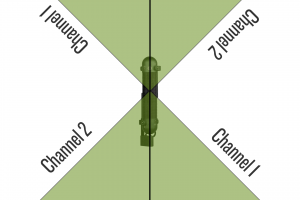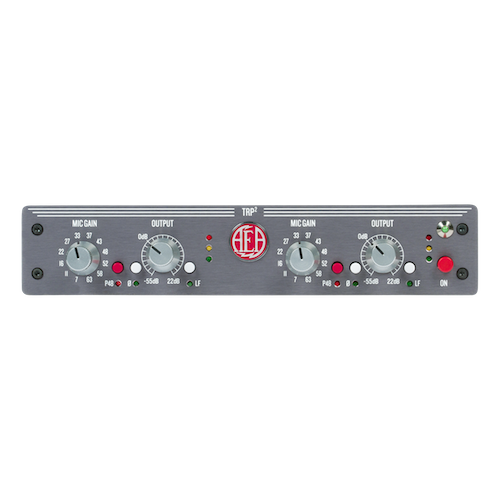The R88, known for its ability to superbly capture ensembles, entire bands and full orchestras from afar, is also very effective in close range applications with quieter sources. The R88’s wide stereo image can lend incredible detail and depth to even one source instrument. This versatility is especially useful up close on instruments like stereo electric guitar amps, woodwinds, and singer-songwriters.
Where to begin
Understanding the R88’s areas of acceptance is vital in order to effectively capture any source, near or far. The ribbon elements within the R88 are affixed in perpendicular Blumlein configuration, providing two 90 degree areas of acceptance on either side, as detailed in the diagram below.
To begin, aim the white reference line of the R88 directly at the center of the source. This orientation will provide a balanced stereo spread in the two channels of the microphone. Because the two ribbon elements are perfectly in phase with one another, you can pan the two channels as you see fit. Many engineers pan each channel hard left and right respectively. This method creates the widest and most natural stereo spread.
The diagram below details the ‘areas of acceptance’ of the two ribbon elements within the R88. The areas shaded green define the R88’s areas of acceptance. When recording ensembles, ensure the musicians are positioned within these regions. When both channels of the R88 are hard-panned left and right respectively, the stereo image will reflect the positions of the various sources in the room.

Singer-songwriters
In this installment of the AEA Sessions video series, singer-songwriter, Ashley Campbell, gives a heartfelt performance of the country classic ‘I Catch Myself Crying’ and a lone R88 is there to capture the detail present in Campbell’s fingerpicked guitar and smooth, bright vocals. This session demonstrates the ability of the R88 to effectively record sources at a closer range while still capturing the way the instruments or vocals interact with the space they inhabit.
The R88 is positioned 3 feet away from Ashley, where it captures a balanced mix of the vocals and the acoustic guitar without the need to mic each source individually.
Electric Guitar
The R88 can be used to effectively capture the sound of stereo guitar amps and create an immersive stereo effect that sounds as though your ears were up against the speaker. In the following audio clip, guitarist Julien Bitoun’s Magnatone guitar amp is captured with an R88.
The R88 can also be used to add stereo width and dimension to a single channel amp. Start by positioning your R88 roughly 8 inches away from the amp. This orientation provides a balanced treble-to-bass ratio as well as a clear stereo image.
Acoustic Guitar
The R88 can be used to capture solo acoustic guitar. Positioning the R88 far back will capture the sound of the instrument in the greater context of the space, but by pulling the R88 in closer, roughly 12 inches away from the guitar, you will capture a more direct sound of the instrument. Aiming the white reference line of the R88 at the point where the guitar’s neck meets its body will provide a balanced, natural image of the acoustic guitar with less room tone.
Brass and Woodwinds
The R88 is a great choice for capturing solo woodwinds and brass instruments at close range.The balanced response of the R88 between 3 and 4 feet from the instrument makes it highly effective at capturing a woodwind’s full range of tonality. One can temper the R88’s pronounced proximity effect by moving it farther from the source, or having the instrumentalist move the instrument forward or back based on the dynamics of a performance.
No fuss with two mics
Since the R88 is a fixed Blumlein array, it delivers stable, in-phase sound stages with an excellent sense of depth. Because the two ribbon elements are perfectly in phase with one another you can pan the two channels as desired, without concern for phase issues.
Up close and personal
Loud sources won’t damage the R88, as it can handle 165+ dB SPL at 1 kHz allowing for worry-free close range recording.




